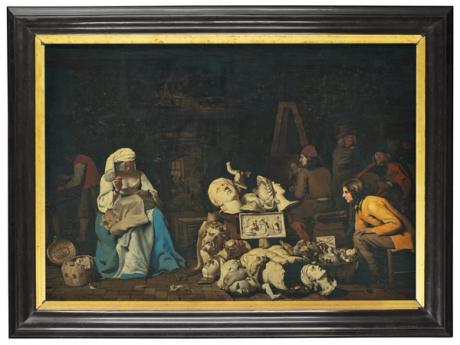
Michael Sweerts (1618-1664) may not be a household name, but this Brussels-born artist has just become the benchmark in the Old Master market after his long-lost painting, The artist’s studio with a seamstress, sold on Thursday at Christie’s for a record £12.6m (with fees). The price was six times the low pre-sale estimate and four times the previous auction record for an artist little known outside of the Old Master world.
Believed to have been made around 1646-1649 in Rome, where Sweerts lived in his late twenties and early thirties before returning to Brussels, this enigmatic canvas shows the interior of a bustling studio with an artist painting a seamstress. The model is admired by a young studio assistant, seated next to a pile of plaster casts of classical sculptures. In the shadowy background, another artist can be seen at work through an open doorway.
The composition, perhaps the most ambitious of several made by Sweerts on the subject of the artist’s studio, was known from various copies. This previously unknown signed original recently emerged from a home in France in spectacularly untouched condition, covered in centuries of grime on its original stretcher. Every detail, including the seamstress thread and the glittering thimble, has been perfectly preserved.
“There are all the elements you want in a picture. The mood, the characters, the objects, the background. Everything is perfect,” says Bob Haboldt, a specialist Old Masters dealer with galleries in Amsterdam. , New York and Paris, who was one of at least half a dozen bidders for the painting. “An intact image like this is very rare on the market,” adds Haboldt. Over the years he has manipulated several works by Sweerts. “It was a painting that appealed to the tastes of dealers and institutions.”
The competition eventually turned into a two-way duel between New York dealer Adam Williams who bids in the room on behalf of a customer and a telephone bidder represented by Christie’s Old Master specialist Henry Pettifer, who finally prevailed. Christie’s gave no immediate indication of the identity or nature of the buyer.
However, a well-placed dealer who claimed insider knowledge said the winning bidder was the Antwerp company Phoebus Foundation, formed by the eminent Belgian collectors Karine Karine Van den Heuvel and her husband Fernand Huts, president and chairman of the international port logistics group Katoen Natie. The Phoebus Foundation and Katoen Natie did not respond to a request for comment at the time of publication. A Portrait of a manby Sweerts, from the 1650s, is already owned by the Phoebus Foundation and is this month’s “Painting in the Spotlight,” according to the foundation’s website.
The presence of Sweerts’ masterpiece and other fresh-to-market paintings from more renowned names such as Rembrandt and Fra Angelico helped Christie’s raise £53.9m (with fees) across 38 lots, the total the house’s highest for an Old Master auction in London since 2016, with 26% of works going unsold.
The auction room was much more crowded, the atmosphere much more positive than at Sale of Old Masters Sotheby’s the night before. “It was like night and day. It was a completely different feeling,” said Anthony Crichton-Stuart, director of London-based art dealership Agnews. “Given their rarity, paintings like the Sweerts drive the whole sale up.”
Basically, Christie’s two best lots were finds and neither was encumbered with the financial mechanism of a pre-sale guarantee, which underpinned most of the higher prices at Sotheby’s. “It sucks the life out of an auction house,” says Crichton-Stuart. “You might as well not be here.
Christie’s other main draw was Rembrandt’s small, but extremely characteristic and unrestored oval portraits of his elderly parents, Jan Willemsz. van der Pluym and Jaapgen Carels, signed and dated 1635, estimated between 5 and 8 M£. Believed to be the last pair of Rembrandt portraits left in private hands, these had been entrusted to the trust of a British family who had acquired them from Christie’s in 1824 for 13 guineas, a modest price for Rembrandt at the time. .
Almost two centuries later, the Rembrandts, like the Sweerts, attracted multiple bidders, only to be knocked down for £11.2million. Here, the successful buyer was a stranger in the room, seated next to Taco Dibbits, director of the Rijksmuseum in Amsterdam, who encouraged the bidding. Presumably, at some point, the portraits will reappear on the walls of this museum.
At Fra Angelico’s Crucifixion with the Virgin, Saint John the Baptist and the Magdalen at the foot of the cross, an early work by the Florentine master, dating to around 1420, was discovered in the collection of the long-wealthy Marquesses of Northampton in 1996 by Francis Russell, British vice-president of Christie’s. The family had now decided to sell, but with the assurance of a guaranteed minimum price of around £4million. The restored condition of the gold bottom was seen by dealers as another factor in the competition being more low-key here and only one additional bidder pushed the price up to £5million, although a record for the artist.
“For key pieces, this market is more than ever dependent on discoveries,” says Johan Bosch van Rosenthal, an Amsterdam-based art consultant. “The middle market is very selective and has slowed down in mainstream works to taste, with a few exceptions for specific reasons, such as works by female artists,” he adds.
The rediscovered painting of Artemisia Gentileschi, Allegory of Sculpture, sold for £1.9m against a low estimate of £300,000. The savvy seller had bought it as an unrecognized ‘sleeper’ for around £30,000 at an auction in Denmark in September.
But with prices for contemporary art ever soaring, there may be signs that the market for historic works isn’t just the same old, same old. Christies claims that 35% of buyers at its various Classic Week sales in London were from Asia. More importantly, the auction house says 36% of new entrants to these sales were millennials.
